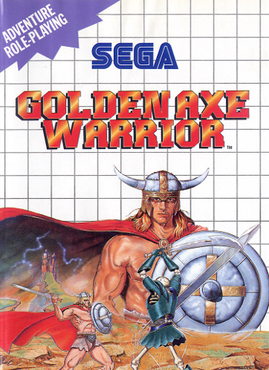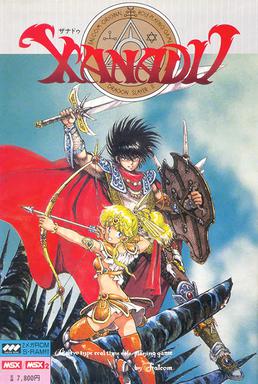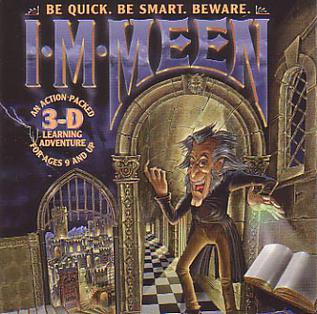
Roguelike is a style of role-playing game traditionally characterized by a dungeon crawl through procedurally generated levels, turn-based gameplay, grid-based movement, and permanent death of the player character. Most roguelikes are based on a high fantasy narrative, reflecting the influence of tabletop role-playing games such as Dungeons & Dragons.
Wizardry is a series of role-playing video games originally created by American publisher Sir-Tech. The series was influential in the evolution of modern role-playing video games alongside Ultima and Might and Magic. The original Wizardry was a significant influence on early console role-playing games such as Shin Megami Tensei, Dragon Slayer, the Shining series, Fire Emblem, Final Fantasy and Dragon Quest. Originally made for the Apple II, the games were later ported to other platforms. The last game in the original series by Sir-Tech was Wizardry 8, released in 2001. There have since been various spin-off titles developed for the Japanese market.

Milon's Secret Castle, known in Japan as Meikyū Kumikyoku: Milon no Daibōken, is a 1986 action-adventure game released by Hudson Soft for the NES. A Game Boy version was released in 1993. A sequel, DoReMi Fantasy, was released in 1996 for the Super Famicom.
The Eggerland (エッガーランド) series consists of several puzzle games developed by HAL Laboratory. Its first release was in 1985 for MSX computer systems. The gameplay is almost exactly the same across the series, with only a few changes over the years, mainly graphical.

Golden Axe Warrior is an action-adventure role-playing video game, developed and published by Sega. It was released on the Master System in 1991 as a spin-off of the Golden Axe video game series. The game follows a young warrior who tries to avenge the death of his parents by exploring ten labyrinths, collecting nine missing crystals and battling with the evil tyrant Death Adder. Players must cross a large world, fight enemies, seek mysterious labyrinths, fight bosses, and obtain the crystals that are guarded by many monsters. All the playable characters from the original Golden Axe make cameo appearances.

Lagoon is a top-view action/adventure video game for the X68000 and Super NES, in which Nasir, Champion of Light, must investigate the source of the world's corrupted water and return peace to Lakeland.

Wonder Boy III: Monster Lair is a side-scrolling action game developed by Westone Bit Entertainment that was originally released for the arcades by Sega in 1988. It is the third game in the Wonder Boy series and the last one released for the arcade. A console adaptation was made by Hudson Soft, released in 1989 in Japan for the PC Engine CD-ROM² System and the subsequent North American release on the TurboGrafx-CD dropped the 'Wonder Boy III' title. It was also converted and released by Sega for the Mega Drive in Japan in 1990 and Europe in 1991. Both, the TurboGrafx-CD and Mega Drive versions have been re-released for the Wii Virtual Console.

Monster World IV is an action-adventure platform game developed by Westone and released in Japan by Sega for the Mega Drive in April 1994. The game title is slightly confusing: It is the sixth game in the Wonder Boy series and the fourth game in the Monster World subseries. It was later released for the PlayStation 2 on March 8, 2007, as part of the Sega Ages 2500 series under the name Sega Ages 2500 Series Vol. 29: Monster World Complete Collection. It was released on the Wii's Virtual Console service in Japan on January 15, 2008. An English-language version was released in North America and Europe for Virtual Console on May 10, 2012, with a release on Xbox Live Arcade and PlayStation Network to come on May 22, 2012. Monster World IV was the last Wonder Boy game to both be published by Sega and developed by Westone Bit Entertainment. A remake by Artdink, titled Wonder Boy: Asha in Monster World, was released in May 2021.

Dragon Slayer IV: Drasle Family, released outside Japan as Legacy of the Wizard, is a 1987 action role-playing platform video game developed and published by Nihon Falcom for the MSX2. A port for the Nintendo Entertainment System was released in Japan in July 1987 by Namco and internationally in 1989 by Broderbund. It is the fourth installment of the Dragon Slayer series, and one of only five Dragon Slayer games that were localized outside Japan. The game was an early example of an open-world, non-linear action RPG, combining action-RPG gameplay with what would later be called "Metroidvania"-style action-adventure elements. Namco's successor, Bandai Namco Entertainment later released the NES version on the international version of Namcot Collection.

Diablo II: Lord of Destruction is an expansion pack for the hack and slash action role-playing game Diablo II. Unlike the original Diablo's expansion pack, Diablo: Hellfire, it is a first-party expansion developed by Blizzard North.

Xanadu, also known as Xanadu: Dragon Slayer II, is an action role-playing game developed by Nihon Falcom and released in 1985 for the PC-8801, X1, PC-8001, PC-9801, FM-7 and MSX computers. Enhanced remakes were later released for the Sega Saturn, PC-9801 and Windows platforms. It is the second entry in the Dragon Slayer series, preceded by Dragon Slayer and followed by Dragon Slayer Jr: Romancia, which, as most games in the Dragon Slayer series, have little relation with each other.

Fate: Undiscovered Realms is an action role-playing roguelike video game developed by WildTangent and released on July 17, 2008, as a stand-alone expansion to the 2005 PC game Fate. The retail version sold in stores includes the original game as well. It was followed by a second expansion, Fate: The Traitor Soul, in 2009.

I.M. Meen is a 1995 fantasy educational game for DOS to teach grammar to children. It is named for its villain, Ignatius Mortimer Meen, a "diabolical librarian" who lures young readers into an enchanted labyrinth and imprisons them with monsters and magic.

A first-person shooter (FPS) is a video game centered on gun fighting and other weapon-based combat seen from a first-person perspective, with the player experiencing the action directly through the eyes of the main character. This genre shares multiple common traits with other shooter games, and in turn falls under the action games category. Since the genre's inception, advanced 3D and pseudo-3D graphics have proven fundamental to allow a reasonable level of immersion in the game world, and this type of game helped pushing technology progressively further, challenging hardware developers worldwide to introduce numerous innovations in the field of graphics processing units. Multiplayer gaming has been an integral part of the experience, and became even more prominent with the diffusion of internet connectivity in recent years.

Diablo III: Reaper of Souls is an expansion pack for the action role-playing video game Diablo III. It was revealed at Gamescom 2013. It was released for the PC and Mac versions of Diablo III on March 25, 2014. The expansion pack content was released as part of the Diablo III: Ultimate Evil Edition version for consoles on August 19 for the PlayStation 4, Xbox One, PlayStation 3, and Xbox 360. That edition expanded the base Diablo III game on the PlayStation 3 and Xbox 360, and brought the game for the first time to the PlayStation 4 and Xbox One.

Rastan Saga, known as Rastan in North America, is a side-scrolling hack and slash arcade video game released by Taito in 1987. It was a critical and commercial success and was ported to home platforms. On May 2, 2024, the arcade version of the game got ported as part of the Arcade Archives series.

Slay the Spire is a 2019 roguelike deck-building game developed by the American indie studio Mega Crit and published by Humble Bundle. The game was released in early access for Microsoft Windows, macOS, and Linux in late 2017, with an official release in January 2019. It was released for PlayStation 4 in May 2019, for Nintendo Switch in June 2019 and for Xbox One in August 2019. An iOS version was released in June 2020, with an Android version released in February 2021.
Dragon Age II is an action role-playing video game developed by BioWare and published by Electronic Arts (EA) for Microsoft Windows, PlayStation 3, Xbox 360 and OS X. It is the second major game in the Dragon Age series and was released worldwide in March 2011. The game features a total of six downloadable content packs that were released from November 2009 to September 2010 on Xbox Live, PlayStation Network, and BioWare's website. Most of these content packs feature new quests and new locations for players to access in the base game, as well as new items for the player to make use of. Two story-focused content packs serve as standalone side stories from the base game, both of which advance the narrative of the Dragon Age series as a whole: Legacy, and Mark of the Assassin.

Record of Lodoss War: Deedlit in Wonder Labyrinth is a 2021 action role-playing video game developed by Team Ladybug and co-published by Playism and Why so serious? for Microsoft Windows. Versions for Nintendo Switch, PlayStation 4, PlayStation 5, Xbox One, and Xbox Series X and Series S were also released. It is based on Ryo Mizuno's Record of Lodoss War series, taking place before the events of The Crown of the Covenant. Controlling the high elf Deedlit, who finds herself in a strange interconnected labyrinth filled with her past foes and companions, the game focuses on exploration and searching for items and power-ups in the vein of Castlevania: Symphony of the Night, fighting bosses and minibosses. During gameplay, the player also locates two elemental spirits and swaps between each one.

Infernax is a Metroidvania video game developed by Berzerk Studio and published by The Arcade Crew. It was released on February 14, 2022, for Nintendo Switch, PlayStation 4, Windows, Xbox One, and Xbox Series X/S. The game follows the young Duke Alcedor, who finds his village overrun by monsters upon returning from the Crusades. Infernax received generally favorable reviews. An update to the game, Deux or Die, was released on April 5, 2023, in which another player can join in as Cervul the Squire.
















